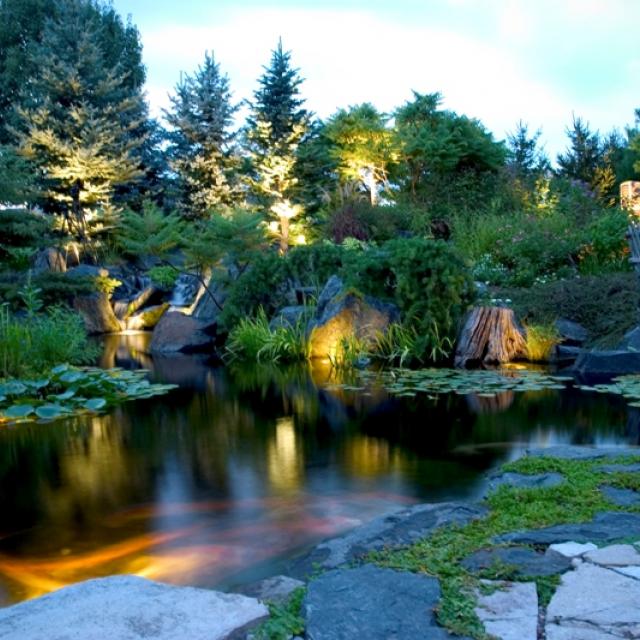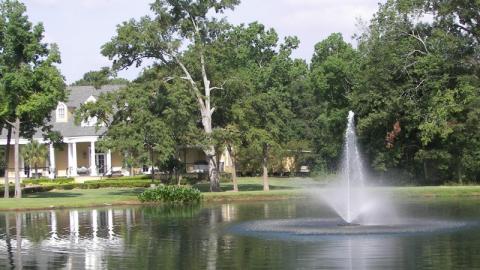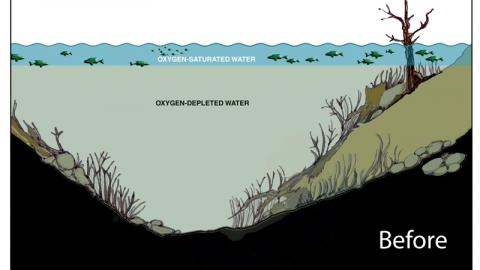Backyard ponds and lakes come in every shape and size imaginable. They can be as little as a fraction of an acre backyard pond to a few acre farm pond to a several hundred acre lake. These can be man made or natural bodies of water and each can vary greatly.
As a whole, most backyard ponds, farm ponds, and lakes are not managed to prevent water quality problems. The few that are managed, usually are managed for curing symptoms rather than preventing the actual problem. If left alone, this can eventually contribute to the "death" of a pond or lake.
Ponds and lakes go through a natural aging process, and considering the "goal" of the erosion process is to fill in low areas with eroded earth from tall areas, the progression eventually fills in the pond or lake. Also, each pond or lake has several segments or zones. Knowing these zones and the general aging process of your pond or lake can help you manage your pond and slow down the aging process.

Pond and Lake Lifecycle
Typically ponds or lakes are in either the Oligotrophic, Mesotrophic, or Eutrophic stages of live (listed youngest to oldest).
Oligotrophic bodies of water are considered new or young ponds or lakes in the overall scheme of things. Oligotrophic bodies have a low concentration of nutrients, such as nitrogen and phosphorus. They typically have steep sloping shorelines and are deep, clear ponds or lakes. The bottom of the pond or lake is typically sand, gravel, or rock. Since oligotrophic lakes have little nutrients in them, they do not produce an abundance of aquatic plants and algae; therefore, they do not need as much treatment for water quality problems.
Mesotrophic bodies of water are considered middle aged, geologically. Mesotrophic lakes fall in the middle, between oligotrophic and eutrophic lakes. They have more nutrients and, therefore, more plant and algae growth than oligotrophic lakes and pond, but less than eutrophic. As a pond or lake ages from oligotrophic to mesotrophic, the sides of the pond begin to slope less and the bottom of the pond begins to fill in with organic material. The substrate that was once rock, sand, or gravel, now consists of mud on top of the rocks. Since Mesotrophic lakes have enough nutrients to produce plants and algae, they are in need of some treatment to slow down the aging process.
Eutrophic bodies of water are considered old or dying ponds or lakes. Eutrophic lakes and ponds are extremely well nourished with nitrogen and phosphorus, leading to an abundance of aquatic plant growth. As the pond or lake continues to age, the sides continue to flatten out and what were once steep sides is now gently sloping. The bottom of the pond is now filled with organic sediment and mud. The overall depth of the pond or lake is continually decreasing and the clarity continues to decrease. As the pond or lake fills in and the weeds grow larger, the total open water area shrinks as well. If left alone, the pond or lake will eventually fill in completely, and become a swamp or wetland at best. Most existing farm ponds fall in the eutrophic category and need help quickly to slow the aging process.
Treating the Symptoms
This all may paint a bleak picture, knowing your beautiful pond or lake is doomed. However, the overall aging process takes a long time and there are things that can be done to slow the process. As mentioned in the opening paragraphs, most ponds, if managed, are managed to treat symptoms of poor water quality rather than preventing the problem.
Algae, aquatic plants, and the gradual aging and filling in of your pond or lake are symptoms. Most ponds that are managed are managed by treating these symptoms. There are several options for algae control and aquatic plant control. However, just treating the symptoms repeatedly can be costly and you are doing nothing for the actual problems.
The root of the problem with the aging of a pond and water quality problems in those ponds is an abundance of nutrients. Oligotrophic lakes and ponds, although considered young bodies of water, can be hundreds of years old. Conversely, eutrophic lakes and ponds, although considered old bodies of water, can be as little as a few years. This is because of the nutrients.
How the Aging Process is Sped Up
Humans and human activity can greatly speed up the aging process of a pond or lake. The nutrients come from point and non point source pollution. Point source pollution (although may not be considered pollution by typical standards) can be fertilizers added to the water to promote weed growth, fish food which adds nutrients with the excess and also speeds up metabolic process within fish to produce more waste, and wildlife waste that is added directly to the pond. Basically, point source pollution is anything added directly to the water. This type of problem is usually a little easier to fix. Most of the time, just stopping activities that add the nutrients will do wonders (like fertilizing and feeding excessively).
Non point source pollution, on the other hand, is nutrients added to the water from offsite. This can be from runoff of fertilized lawns, cattle pastures, leaky sewers and septics, etc. These nutrients are added to the system, but are not being added directly to the water. Non point source pollution is typically a larger concern than point source and more difficult to remedy. With runoff and other non point source pollution, the best way to fix the problem is to keep the nutrients from entering the pond. This can be done by adding a buffer area that will use up the nutrients before they enter the pond, creating a diversion of the runoff so it doesn't reach the water, or eliminate the source altogether (ex. not fertilizing the lawn).
Wherever the excess nutrients are entering your pond, these added nutrients are supplying aquatic plants with more than enough to grow rapidly. The added growth will make your pond an eye sore while growing, but when the plants die off, the greatly contribute to the aging of your pond. As the dead plants decompose, the organic matter and soil begin to build up in the benthic zone or bottom of the pond. Overtime, the sludge and soil builds up and starts to fill in the pond. An oligotrophic pond can quickly turn into a eutrophic pond with all these added nutrients, weed growth, and organic muck on the bottom.
Combating Pond and Lake Aging
There is hope for your pond or lake, though. There are a few ways to slow the process or even reverse it. A costly and large undertaking, but effective process, is dredging. Dredging is physically removing the organic matter and soil from the pond or lake. The body of water that has filled in over the years is renewed by basically re-digging it. By doing so the pond becomes younger and many of the nutrients are removed. This can be a very large project, needing large machinery, time, and money to accomplish, but you can successfully renew your pond.
Another way to slow the process is physically removing the aquatic plants before they get a chance to decompose and add to the organic matter on the bottom of the pond. Cutting, raking, pulling, etc. are all ways to remove the plant growth. It is essential that the weeds are completely removed from the water and moved far enough away that wind or rain does not wash them back into the pond. This will be a long term project and you will put a lot of hours and effort using this method, but over time you can successfully slow the aging process.
The least intensive, as far as manual effort, is adding aeration and water agitation. Adding aeration is an effective tool to reducing the amount of nutrients available for plants and keeping a pond young.
An aeration device will provide your pond or lake with the oxygen it needs. This added oxygen is not only good for the fish and other organisms in the pond; it also helps speed up decomposition. With oxygen, bacteria can decompose organic matter through aerobic decomposition. This is a much faster method than anaerobic decomposition or decomposition without oxygen. The dead organic matter that has built up in your pond over the years will be broken down quicker with oxygen present. This will gradually reduce the amount of sludge and muck on the bottom through the process of bioaugmentation. Bioaugmentation is the process of turning organic sludge on the bottom of the pond into carbon dioxide and then venting the carbon dioxide out of the water. The bacteria will decompose the organic sludge which produces carbon dioxide.
If the carbon dioxide remains in the water, it is still available for plant growth. However, if it is exposed at the air/water interface, the carbon dioxide will vent off into the air. This is another great benefit to surface aeration and agitation. A surface aerator will splash the water, adding oxygen. It also exposes a larger surface area of the water to the air for venting carbon dioxide and helps get the water column mixed so carbon dioxide can vent off effectively.
The aeration and water movement will also help limit algae and plant growth in the pond to improve the overall aesthetics. The water movement limits the amount of sunlight that penetrates the water and limits the amount of stagnant water in the pond or lake, which plants and algae love.
Overall, adding an aerator, like a Kasco Pond Aerator or Aerating Fountain will help improve your ponds aesthetics by helping to limit aquatic plant growth and help keep your pond young. The aeration will help decompose organic sludge quicker and the agitation of the water will help remove carbon dioxide and other nutrients. However, the aeration will be much more effective if the amount of incoming nutrients are limited and the existing aquatic vegetation is removed. By employing these three tactics, you can successfully slow and reverse the aging process of your pond or lake while improving the aesthetics, enjoyment, and habitat for fish and wildlife.


